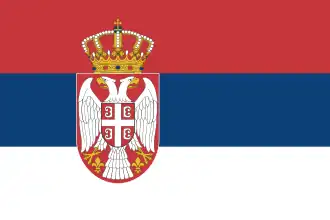Coat of arms of Triballia
The coat of arms of Triballia[a] is a historical coat of arms attributed to medieval Serbia by various armorials, and is today depicted in several Serbian municipality coat of arms in Šumadija. The motif is of a severed (erased) wild boar's head with an arrow pierced in its mouth or through its head.[1]
Prior to the 19th century the depiction was used for Serbia in armorials but not by the Serbs themselves; it was in use by the Hungarian kings with pretensions over Serbia.[2] In the Habsburg Monarchy, the Flag of Serbia (Latin: Vexillum Serviae) with this depiction was one of the flags given to an honorary flag-bearer during the coronation of the King of Hungary, since 1563.[3] In the Chronicle of the Council of Constance of Ulrich Richental from 1415, during the reign of Serbian Despot Stefan Lazarević, the motif is used as the coat of arms for the Serbian Empire.[4] Conrad Grünenberg used it for "Serbia" in 1483.[4] It was used to depict historical Serbia in numerous armorials dating between the 15th and 18th centuries, alongside the white double-headed eagle and cross with four firesteels. Interestingly, it was not used in any of the Illyrian Armorials.
The coat of arms of Serbia (a cross with four firesteels) and "Trivalija" (a boar head pierced with an arrow, denoting Šumadija[5]) were included in the coat of arms of the Governing Council of Revolutionary Serbia upon its establishment in 1805.[6][b] The usage of the name Triballia with this depiction comes from the Stemmatografia (1701) of Ritter-Vitezović who claimed that "Hungarian kings used the old symbol of Triballians for the kingdoms of Serbia and Rascia, and the seat of the Triballians was in Serbia",[7] and was popularized through the later edition of Stemmatografia of Hristofor Žefarović (1741).[8] The Triballi were an ancient tribe whose name was used as an exonym for the Serbs by archaizing Byzantine authors in the Middle Ages.[9] Jovan Vladimir (r. 1000-16) was called the ruler of "Triballians and Serbs".[10]
It is today used in several of the municipalities and cities of Šumadija in central Serbia, based on the usage in the Serbian Revolution (1804–17).
Gallery
Historical
-
 "Serbian emperor", Prussian ed. Chronicle of the Council of Constance (before 1437)
"Serbian emperor", Prussian ed. Chronicle of the Council of Constance (before 1437) -
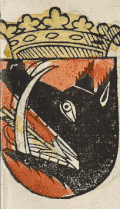 "Serbia", in later ed. Chronicle of the Council of Constance (1483)
"Serbia", in later ed. Chronicle of the Council of Constance (1483) -
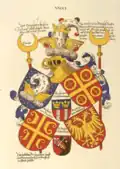 Coats of arms of the Turkish Empire, Constantinople, Palaeologus, Byzantium and Serbia (1483), Conrad Grünenberg.
Coats of arms of the Turkish Empire, Constantinople, Palaeologus, Byzantium and Serbia (1483), Conrad Grünenberg. -
 "Serbia", Wernigeroder Schaffhausensches Wappenbuch (between 1486 and 1492)
"Serbia", Wernigeroder Schaffhausensches Wappenbuch (between 1486 and 1492) -
.jpg) "Serbia" coat of arms, Cathedral of St. Elizabeth (built between 1378 and 1508)
"Serbia" coat of arms, Cathedral of St. Elizabeth (built between 1378 and 1508) -
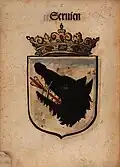 "Serbia", by Johann von Francolin (ca. 1565)
"Serbia", by Johann von Francolin (ca. 1565) -
.png) Banner of Bosnia–Serbia–Bulgaria–Wallachia at the funeral of Ferdinand I (1566)
Banner of Bosnia–Serbia–Bulgaria–Wallachia at the funeral of Ferdinand I (1566) -
 "Serbian emperor", by Christoph Silberysen (1576)
"Serbian emperor", by Christoph Silberysen (1576) -
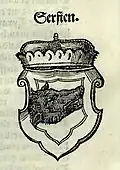 "Serbia", by Martin Schrott (ca. 1580)
"Serbia", by Martin Schrott (ca. 1580) -
%252C_1604.jpg) Unnamed, by Jerome de Bar (1604)
Unnamed, by Jerome de Bar (1604) -
 Sketch of flag of Serbia used at the coronation of Ferdinand II (1618)
Sketch of flag of Serbia used at the coronation of Ferdinand II (1618) -
_Funeral_procession_for_Albert_VII%252C_Archduke_of_Austria.jpg) Funeral procession for Albert VII, Archduke of Austria with the coat of arms of Kingdom of Serbia (1623)
Funeral procession for Albert VII, Archduke of Austria with the coat of arms of Kingdom of Serbia (1623) -
Coat of arms of Kingdom of Serbia at Belgrade fortress (1717)
-
.png) Coat of arms of the Kingdom of Serbia (1720)
Coat of arms of the Kingdom of Serbia (1720) -
.svg.png) Coat of arms of the Kingdom of Serbia
Coat of arms of the Kingdom of Serbia -
"Allegorical representation of Transylvania and Serbia" (1723), Altomonte
-
.jpg) "Triballia" coat of arms, Stemmatographia (1741)
"Triballia" coat of arms, Stemmatographia (1741) -
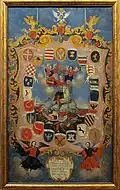 Emperor Dušan with coats of arms of Serbian lands (ca. 1750), Jov Vasiljevič, National Museum of Serbia
Emperor Dušan with coats of arms of Serbian lands (ca. 1750), Jov Vasiljevič, National Museum of Serbia -
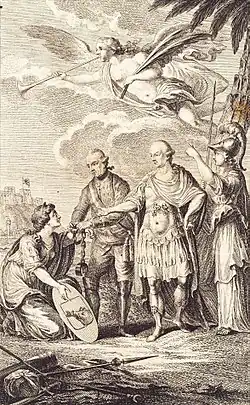 "Liberated Serbia" (1800s), Johann Georg Mansfeld
"Liberated Serbia" (1800s), Johann Georg Mansfeld -
 Sketch of "flag of Serbia" used at the coronation of Leopold II (1790)
Sketch of "flag of Serbia" used at the coronation of Leopold II (1790) -
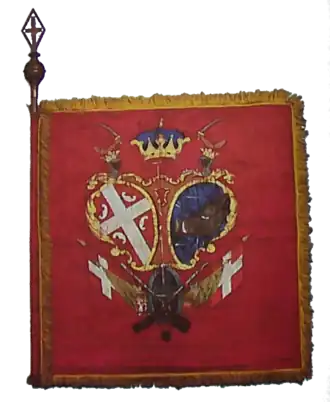 Serbian uprising flag with the coat of arms (1804), Belgrade Military Museum
Serbian uprising flag with the coat of arms (1804), Belgrade Military Museum -
Serbian uprising flag with the coat of arms (1804), Loznica
-
Government seal during the First Serbian Uprising (1804)
-
Government seal during the First Serbian Uprising (1804), Takovo
-
.svg.png) Coat of arms of Kingdom of Serbia in the coat of arms of Hungary (1849)
Coat of arms of Kingdom of Serbia in the coat of arms of Hungary (1849)
Current
Municipalities in Serbia
-
.gif) Greater coat of arms of Barajevo
Greater coat of arms of Barajevo -
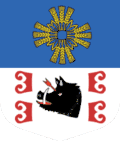 Lesser coat of arms of Barajevo
Lesser coat of arms of Barajevo -
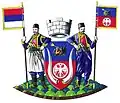 Greater coat of arms of Velika Plana
Greater coat of arms of Velika Plana -
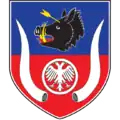 Lesser coat of arms of Velika Plana
Lesser coat of arms of Velika Plana -
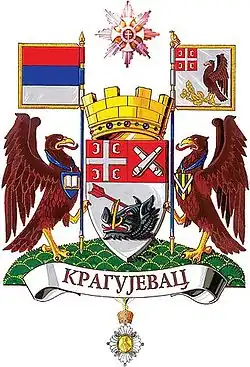 Greater coat of arms of Kragujevac
Greater coat of arms of Kragujevac -
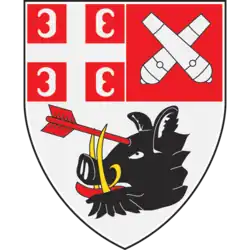 Lesser coat of arms of Kragujevac
Lesser coat of arms of Kragujevac -
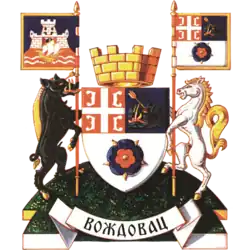 Greater coat of arms of Voždovac
Greater coat of arms of Voždovac -
 Lesser coat of arms of Voždovac
Lesser coat of arms of Voždovac -
 Greater coat of arms of Lajkovac
Greater coat of arms of Lajkovac -
 Lesser coat of arms of Lajkovac
Lesser coat of arms of Lajkovac -
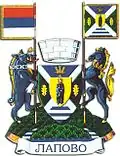 Greater coat of arms of Lapovo
Greater coat of arms of Lapovo -
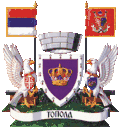 Greater coat of arms of Topola
Greater coat of arms of Topola
See also
Annotations
- ^ Known as Serbian: грб Трибалије, romanized: grb Tribalije, or in archaic form грб Тривалије grb Trivalije, based on Ritter-Vitezović (1701).[11][12] Also called the coat of arms of Šumadija in modern times.[13] It was used in the "Flag of Serbia" (Latin: Vexillum Serviae) by the Habsburg Monarchy.[3]
- ^ At the time of the First Serbian Uprising, there was a native half-primitive breed of Šiška pig which resembled a wild boar.[14] Several of the Serbian revolutionaries were pig traders prior to the uprising and merchants played an important role in it.[14]
References
- ^ Danko Popović; Dinko Davidov (2004). Studije o srpskoj umetnosti XVIII veka. Српска књижевна задруга. p. 18. ISBN 9788637908685.
- ^ Milićević 1995, p. 67.
- ^ a b Pálffy 2010, pp. 43–46.
- ^ a b Centar za mitološki studije Srbije 2006, p. 75.
- ^ Popović 1995, p. 66, Jaćimović 1973, p. 51
- ^ Kraut, Đorđević & Rančić 1985, p. 73, SANU (1957). Posebna izdanja. SANU. p. 130., Arsenijević 1898
- ^ Solovjev 1958, p. 48, Mošin 1939, pp. 9–12
- ^ Milićević 1995, p. 64, Davidov 1991, Skerlić 1966, p. 211
- ^ Papazoglu 1978, p. 9, Srdanović-Barać 1980, p. 81
- ^ Istorijski muzej Srbije 1983, p. 65.
- ^ Solovjev 1958, p. 48.
- ^ Mošin 1939, pp. 9–12.
- ^ Popović 1995, p. 66.
- ^ a b Srdanović-Barać 1980, p. 81.
Sources
- Kraut, Vanja; Đorđević, Miodrag; Rančić, Rade (1985). Istorija srpske grafike od XV do XX veka. Narodni muzej. p. 73. ISBN 9788636700013.
- Centar za mitološki studije Srbije (2006). Mitološki zbornik. Centar za mitološki studije Srbije.
- Srdanović-Barać, Olga (1980). Révolution agraire et l'agriculture serbe depuis Kotshina krajhina jusqu'à la fin du premier regne du Prince Miloš. Srpska akademija nauka i umetnosti.
- Popović, Marko (1995). "Grbovi na javnim zdanjima Beograda (II deo)" (PDF). Godišnjak grada Beograda. XXXXII: 59.
- Mošin, Vladimir A. (1939). Akti iz svetogorskih arhiva. Srpska kraljevska akademija.
- Istorijski muzej Srbije (1983). Zbornik Istorijskog muzeja Srbije. Vol. 20–22. Istorijski muzej Srbije.
- Pálffy, Géza (2010). "A Magyar Korona országainak koronázási zászlói a 16–17. században". In Bubryák, Orsolya (ed.). "Ez világ, mint egy kert…" (in Hungarian). MTA Művészettörténeti Kutatóintézet–Gondolat Kiadó. pp. 17–52.
- Skerlić, Jovan (1966). Sabrana dela Jovana Skerlića. Vol. 8. Prosveta.
- Solovjev, Aleksandar Vasiljevič (1958). Istorija srpskog grba. Srpska misao.
- Milićević, Milić (1995). Grb Srbije: razvoj kroz istoriju. Službeni Glasnik. ISBN 978-86-7549-047-0.
- Jaćimović, Miodrag M. (1973). Lazar Mutap: vojvoda moravski i čačanski. Izdanje autora.
- Arsenijević, Lazar (1898). Istorija srpskog ustanka (in Serbian). Izd. Batalakinoga fonda. Retrieved 2025-07-26.
- Davidov, Dinko (1991). Grb Srbije: Stematografija Hristofora Žefarovića, Beč, 1741 (in Serbian). Ligatura. Retrieved 2025-07-26.
- Dragomir M. Acović (2008). Heraldika i Srbi. Zavod za udžbenike. ISBN 978-86-17-15093-6.
- Aleksandar Palavestra (2010). Илирски грбовници и други хералдички радови. Завод за уџбенике. ISBN 978-86-17-17266-2.
- Papazoglu, Fanula (1978). The Central Balkan Tribes in pre-Roman Times: Triballi, Autariatae, Dardanians, Scordisci and Moesians. Amsterdam: Hakkert. ISBN 9789025607937.
